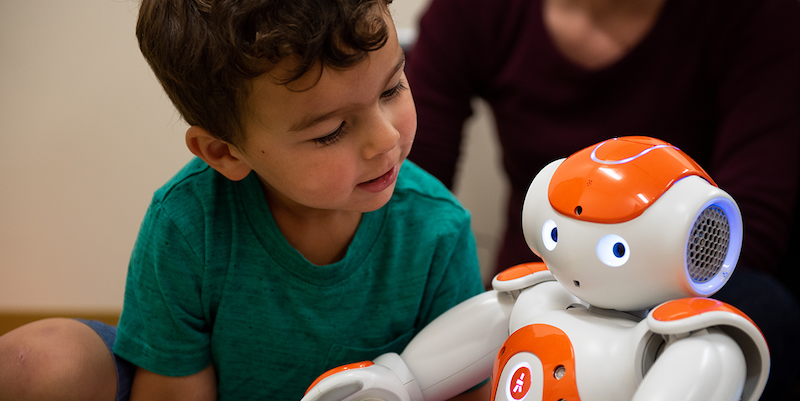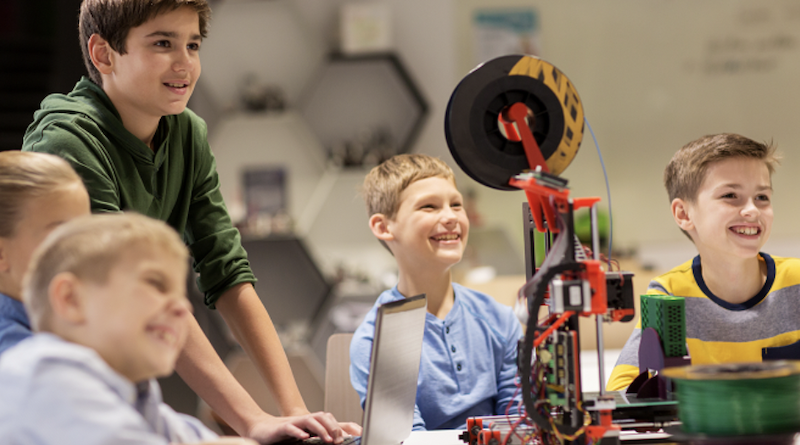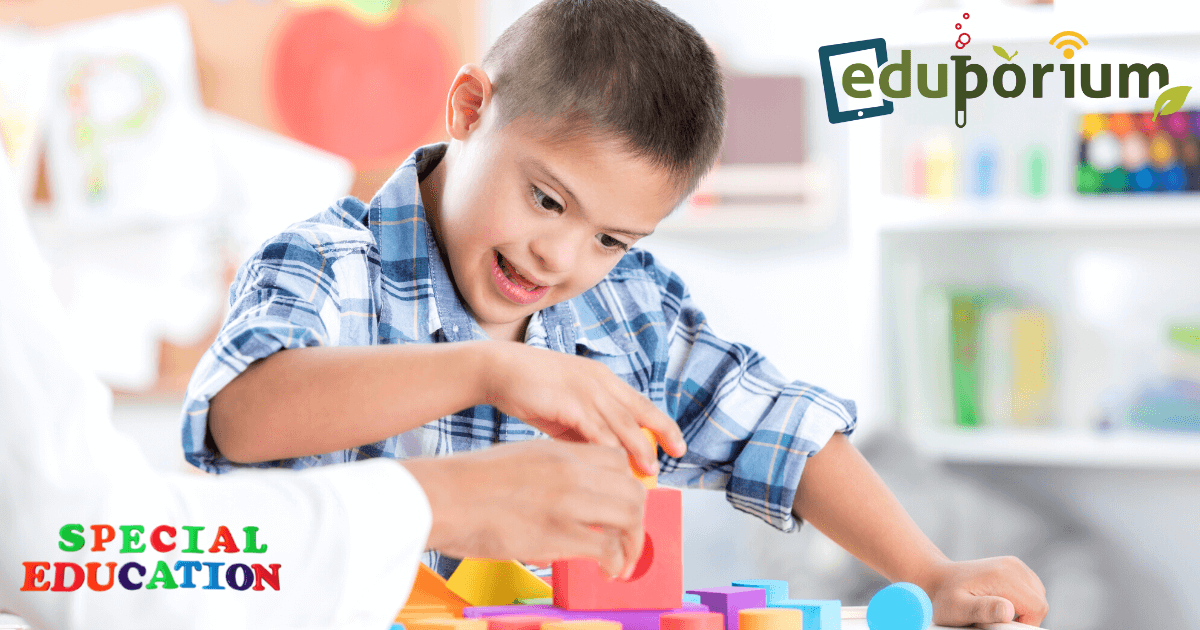Every student learns in a different way and this is, of course, true for special education students. While they do learn differently and have specialized classes with dedicated instructors, that’s not to say that they can’t accomplish everything that children in your general classrooms can do. One trusted way to engage special education kids, keep their interest, and illustrate key concepts is by using educational technology. Coding tools, makerspace materials, and other STEAM solutions all help them work with their hands and activate their brains. And, when special education students see that they can use technology tools to accomplish the same things as other students, they feel a greater sense of inclusion, learn key skills, and more.
Tech Trends in Special Education
We’ve been aware that many educational technologies have benefits for special education students for a while now. When EdTech and STEM tools first became popular, educators discovered that they could also use them with special populations too. Now, more manufacturers are creating new, specialized versions or standalone tools for dedicated use in special education. The findings have been that EdTech tools that are similar to (or often the same as) the ones used in mainstream classrooms can truly help special education students learn. Many EdTech manufacturers now keep special education children in mind while designing solutions that are compatible with all types of learners. This has helped create greater equity in education and ensured that all students have equal opportunities for advancement.
Tech tools that work in special education.
All types of technology—when implemented effectively—can boost special education instruction, including VR and robotics kits among others. If any student inquires about and processes information differently, the addition of EdTech tools might be good for them. That’s a basic example of some benefits EdTech provides and here are some more specific ones. One of those is that technology allows for greater personalization in the classroom. If working with blind students, for example, many STEM tools today, particularly in robotics education, have auditory elements and tactile components so that kids could still use them without having to see everything they are working with. Since these tools are so versatile, children with hearing disabilities and general intellectual shortcomings can also use them. EdTech tools can also help educators diagnose a learning disability in their students, which often goes overlooked.
Using VR in special education classrooms.
We mentioned virtual reality as a technology that could help special education students. While it could help them in the classroom by viewing content in a more in-depth way, it could also benefit some other types of students as well. Those kids with social anxiety and even Autism can use VR to practice being in everyday situations like simply walking through the school hallway. Another trend in special education technology is the incorporation of greater accessibility. This might include more videos in learning or other elements that complement the abilities and preferences of students. Finally, schools with special education students are learning more on open educational resources or OER. These resources are highly adaptable and teachers can adjust them for students with various learning challenges. And, as time goes on, the technology may only become more conducive to universal use among students.
Bringing Assistive Tech into the Classroom
Often, technology that helps special education students learn is referred to simply as assistive technology. Technically, this includes all tech supplies they could use, but also refers to tech tools made specifically for certain students. An example of that is a keyboard with extra large keys so that students who struggle with pinpointing keys that are the traditional size would still be able to type. Many STEM tools today also work in a similar way and serve students with various physical and intellectual disabilities. Most often, when we talk about ‘assistive technologies,’ we’re referring to tech that could help children with physical disabilities. These tools are often affordable for educators and provide special education students with a lot of benefits, including greater access to experiential learning and the chance for greater equity in the classroom.
Assistive technology examples.
Any pieces of technology that educators could modify, customize, or use to increase, maintain, or improve student functional capabilities is an assistive technology tool. This includes low-tech and no-tech items, so it’s not only the digital or electronic tools that are assistive. And, assistive tech doesn't only refer to tangible technologies—lots of these are digital, like what we know as closed-captioning. Plus, it's a perfect way for children to both hear about something and to see it written out, helping reinforce key points and make sure they remember. One form of no-tech assistive technology is a graphic organizer. Children who have various learning challenges when it comes to writing, like dyslexia, for example, can use these devices to visually organize their thoughts and create relationships for when they’re writing.
Flexible seating and other classroom strategies.
Another no-tech option for helping students focus is to use flexible seating. When sitting in a chair, special education kids could get antsy and easily lose focus on their work. With a more comfortable space, like on a beanbag, for example, they might focus more effectively. Educators can also do a lot to help these types of students understand how to manage their time better. Visual timers, like hourglasses, help students see how much time to spend on a task and when to move on. Also pretty low-tech, but these simpler tools are very helpful. Finally, many students have found success using speech-to-text software like what's found in Google Docs. For those who have trouble typing (and/or focusing), this can be a great way to make things more efficient. Plus, it can even help them see the benefits of different types of technology.

How Mainstream Technology Can Boost Special Ed
If there’s anything you take away from using technology in special education, we want it to be that special education students can usually use the same tech tools as all other students. They may just have to adapt them to become more conducive to their learning environments. When the right technology is brought into special education classrooms and then integrated effectively, it can do wonders for the development of the students as well as their overall confidence. In addition to that, using newer technologies can help them to feel like they have a place in modern learning. Assistive tech tools, like AV devices and voice amplification tools that we mentioned, are the most common types that educators use with special education students. They’re easy to integrate and pretty versatile and teachers like them because they can be used with other students, too. But, there are more options.
Inclusion in special education programs.
The various forms of educational technology can have a variety of positive impacts on special education students. These types of tools often help them keep pace without drawing extra attention to themselves, for example. Assistive tech helps create more inclusion, which is a big topic in 21st century education at the moment. Take mobile devices, for example. They now have so many different purposes—as we know. Mainstream students can use them to explore countless educational apps and resources while special ed children could use them to explore apps that align with their learning styles. Plenty of Chromebooks and tablets also have assistive features that make everyday learning easier on special education students. One of those most popular features is “select-to-speak,’ which is similar to speech-to-text. This allows kids to highlight words or paragraphs and have them read out loud to reinforce concepts.
How virtual reality helps teachers reach students.
Virtual reality is a mainstream technology that could potentially create a truly significant impact on special education. While it's still likely a long way from becoming mainstream in special education, VR can help to boost engagement by helping students focus and even boost some of their social and academic skills. For students who struggle paying attention, they could utilize VR to immerse themselves in scenes while text is also displayed. And, again, Autistic students can use virtual reality to begin recognizing the expressions on peers' faces as well as practicing how to proceed when faced with some of their daily challenges. While VR certainly is cool to the average person, it can be a whole lot more to special education students. And, that is something that educators should keep in mind as the technology becomes more and more powerful.
VR for Enhancing Special Ed
Yes, VR is one of those up-and-coming mediums that may go either way with its impact on education. The potential is certainly there for it to become completely disruptive, or it could also just fizzle out without ever really gaining much traction. Fortunately, virtual reality has already made a bit of an impact on students and teachers in the short time it has been around with all of its current bells and whistles. It's already proven to be effective at creating diverse ways of learning for different types of students—one of which, of course, is special education students. Effective special education instruction relies heavily on creating a very positive, comfortable, and safe learning environment for these students. The environment should also help bring out their strengths in a group setting. So, how does virtual reality tie into all of this?
The connections between VR and SEL.
Virtual learning tends to help students connect to educational content on deeper levels. And, when they’re more emotionally connected to what they’re learning, they’re more likely to retain it and stay engaged since they are fully focused. Since virtual reality creates student-centered experiences, many educational leaders feel as though it can be used to help connect with and reach special education students in an effective way a lot of the time. The overarching benefit of VR in special education is that it creates better engagement for students. The ways in which it enhances engagement are even incredibly diverse and include transporting children to virtual museums, deep into the ocean, or into space. With VR in learning, special ed students realize they can draw connections to what's familiar and understad what’s different.
Helping special education students develop key skills.
VR in special education learning helps students build communication skills, self-management, decision making, and social awareness, including empathy. Plus, students could theoretically also watch movies and videos in VR, which provides for an extremely immersive experience that is much more likely to keep them engaged. Not only can virtual reality help students develop these key competencies, it can also help provide teachers with an exciting new element to add into their instruction. To take things a step further, if students are able to create their own VR experiences, that’s even better! They'll see what’s most relevant, collaborate, and connect with their peers, which is a huge part of special education. As educators look for new ways to engage special education students and keep their attention (and as VR gets more and more affordable), don’t be surprised to see a long-term marriage between them.

Using Makerspaces in Special Education
Just as EdTech and STEAM tools can enhance special education in the right situations, the same goes for makerspace learning. In makerspaces, students can explore new things, learn that failure is good, problem solve creatively, and collaborate with their peers. If these sound like things you want your special education students trying, then you’d certainly have the right idea! Makerspaces can definitely play a positive role in special education, especially with students who have behavioral, social, or emotional challenges. Since the nature of academic makerspaces promotes this carefree atmosphere, kids can pretty much lead their own learning and they don’t have to attend it every day. Many educators have found success by bringing their students into the makerspace as little as once a week!
Creating tactile learning opportunities.
Makerspace access for special education students presents a steady stream of teachable moments. They can make, invent, and discover with low- or no-tech items and learn how there's often multiple solutions to problems. Of course, you can introduce them to the more high-tech devices as well if they're ready for that and illustrate important scientific concepts in hands-on ways, like how gears work, for example. It is also a great environment for teachers to preach the importance of patience, teamwork, taking turns, and following instructions—some of the most important things for special education students to learn. Especially for kids with emotional and behavioral challenges, they can work on those and see some positive examples of how they should be acting in the classroom and in the real world.
Opportunities to collaborate.
Special education students can work independently or collaboratively in makerspaces and could even start working with others on their own. It’s also common for everyone in a group to start working together, which is fantastic! This hammers home values of teamwork, learning through trial and error, and turn taking in fun and exciting ways. As for teachers, storing and transporting makerspace materials for students does not have to present a huge challenge. As we mentioned, a lot of what they could use are smaller and low-tech. But, even if there are bigger things, they can be stored and transported on mobile carts. Heck, maybe that can even be one of the first projects for students—working together to build that mobile cart. As kids learn together and grow, their makerspace grows with them. They often start small and develop into something great, illustrating what it’s like to evolve through experiences.
For the latest EdTech, STEM, and 21st century education news, follow us on Twitter and Instagram. Like us on Facebook, too, or sign up for our newsletter for our latest product announcements and offerings. If you have an idea for an Eduporium Weekly theme, send us a message on social media or comment below.



